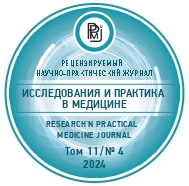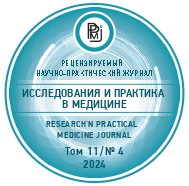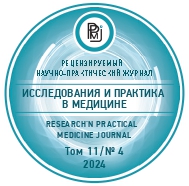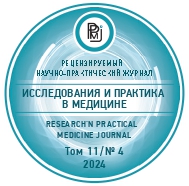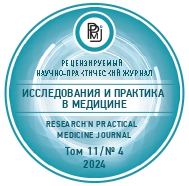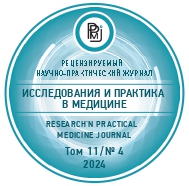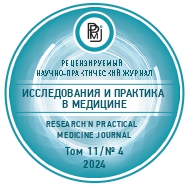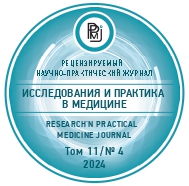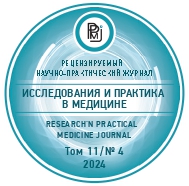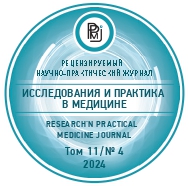Original Articles. Оncology
Purpose of the study. To evaluate and compare the diagnostic significance of vacuum‑ assisted biopsy (VAB) and multifocal trepan biopsy (MTB) methods based on a pathomorphological study of postoperative material in patients diagnosed with breast cancer (BC) in all molecular biological types after neoadjuvant polychemotherapy (NAPCT) with a complete clinical response (cCR).
Patients and methods. The study included 70 patients with cT1–3N0–3M0 breast cancer with different molecular biological types after NAPCT. It was conducted at the P. Hertsen Moscow Oncology Research Institute – Branch of the National Medical Research Radiological Centre from 2021 to 2023. All patients underwent ultrasound and digital mammography before and
after NAPСT to assess the clinical response to treatment. MTB was performed in 35 patients, VAB in 35 patients, followed by surgical treatment. Histological findings obtained by VAB and MTB and surgical material were compared to assess the pathomorphological response of the tumor to treatment.
Results. According to the pathomorphological conclusion, the following results were obtained during the VAB: 1 – truly positive, 29 – truly negative, 3 – falsely negative, 0 – falsely positive. The overall sensitivity of the technique was 25.0 % (CI 6.8–60.2 %); specificity – 100 % (CI 88.1–100 %); false negative result (presence of tumor cells in the surgical material and negative result of VAB) – 9.1 % (CI 3.4–20.2 %); false positive result (absence of tumor cells in the surgical material and a positive result of VAB) – 0 % (CI 0–10.6 %). The overall diagnostic accuracy of the method was 90.9 % (CI 79.8–96.6 %). According to the pathomorphological study, the following was obtained during the MTB: 1 – true positive, 17 – true negative, 5 – false negative and 0 – false positive results. The overall sensitivity of the technique was 16.7 % (CI: 4.3–45.9 %); specificity – (100.0 % CI: 80.5–99.9 %). The false negative result was 23.8 % (CI: 11.3–41.9 %). The false positive result is 0 %. The overall diagnostic accuracy of the method was 78.3 % (CI: 61.2–89.7 %).
Conclusion. The results of the study indicate a higher sensitivity of the VAB method compared to MTB in assessing the pathomorphological response of breast cancer patients after antitumor drug treatment, which shows a vector for conducting large prospective studies of this method.
Serous endometrial intraepithelial carcinoma (SEIC) and clear cell carcinoma of the endometrium (CCEC) belong to pathogenetic type II without evidence of hyperestrogenism, are often detected late in the course of the disease, and are characterized by an aggressive course. Currently, there is increasing interest in the role of local content and metabolism of steroid hormones in organs and tissues in various pathologies, including the development of malignant tumors.
Purpose of the study. To determine the local level of sex hormones in patients with SEIC and CCEC.
Patients and methods. The study included 21 patients with SEIC and 20 patients with CCEC. The control group consisted of 20 patients who had undergone surgical treatment for uterine myoma. All patients were treated at the National Medical Research Center for Oncology, Rostov‑on‑ Don, the Russian Federation Ministry of Health. The local levels of estrogens and androgens were determined in the tumor tissue, the perifocal zone, endometrial tissue unaffected by the tumor process, and the fallopian tube tissue in patients with SEIC and CCEC. In the control group, the local level of sex hormones was determined in intact 10 % homogenic endometrial tissue.
Results. The data were analyzed, and the results demonstrated that the tumors and peritumoral tissues exhibited a depletion of estradiol (E2), a saturation of testosterone, and an extreme saturation of estriol (E3). The consequence of this imbalance was the predominance of fetal placental estrogen (E3), which was detected not only in the tumor tissue but also in distant parts of the endometrium and uterine tubes. In these regions, the concentration of E3 exceeded that of intact endometrium by a factor of more than five. A comparison of estrogen receptor (ER) levels revealed elevated levels in samples of the tumor, its perifocal zone, distant endometrium, and fallopian tubes. This finding indicated a predominance of ERα over ERβ.
Conclusion. The local hormonal background of rare forms of non‑endometrioid endometrial carcinomas exhibits distinctive characteristics, including the replacement of the influence of classical estrogen (E2) by fetal, placental E3. Additionally, there is a notable prevalence of the REα type over REβ, along with hyperandrogenization of tissues, which culminates in the formation of a unique low‑differentiated tumor with pronounced biological aggressiveness.
Purpose of the study. To study the clinical efficacy of pressurized intraperitoneal aerosolized chemotherapy (PIPAC), which complements the combined treatment of ovarian cancer with peritoneal carcinomatosis.
Patients and methods. The study included 175 patients with newly diagnosed ovarian cancer with peritoneal carcinomatosis (87 in the main group, 88 in the control group). All patients underwent extirpation of the uterus with appendages, removal of the large omentum and chemotherapy according to the TC scheme (Taxol, Carboplatin). In the main group, 3 additional sessions of PIPAC were performed. The duration of relapse‑free survival, PCI index, ascites volume and peritoneal morphology were evaluated.
Results. Complete regression of carcinomatosis was noted in the second session of PIPAC, in 44 (52.4 %) patients (PCI = 0); complete resorption of ascites – in 74 (88.1 %); complete therapeutic pathomorphosis – in 48 (57.2 %) cases. Complete regression of carcinomatosis was noted in the third session of PIPAC in 73 cases (87.0 %), complete resorption of ascites in 80 cases (95.2 %), complete morphological pathomorphosis in 69 cases (82.2 %). 6 months after treatment, complete regression of carcinomatosis (PCI = 0) was detected in 81 patients (96.4 %), complete resorption of ascites in 83 (98.8 %), complete morphological regression in 72 (85.7 %). The advantage of the main group in terms of median relapse‑free survival was 7 months.
Conclusion. Ascites resorption, a decrease in the PCI index and drug pathomorphosis of peritoneal metastases, detected during the 2nd session of PIPAC, had an increasing dynamics during treatment and persisted for a long time. From our point of view, the advantage in median relapse‑free survival in the main group is due to the local effect of PIPAC, which complemented the standard treatment of ovarian cancer with peritoneal carcinomatosis.
Purpose of the study. This study aimed to identify the characteristics of the course of cell lung cancer (LC) and the information content of the indicators of the adaptation status of patients of different sexes who had COVID‑19, confirmed by PCR diagnostic results before the start of antitumor treatment.
Patients and methods. We have studied traditional clinical and laboratory parameters, and the white blood cell count in patients with non‑small cell LC st. I–III, men (59) and women (32) aged 36–75 years. The main groups included 32 men and 16 women who had COVID‑19, confirmed by real‑time PCR, 2–9 months before hospitalization. Patients in the control groups denied having a history of diagnosed COVID‑19. Before the start of antitumor treatment, the percentage of lymphocytes in the blood was assessed. Cases of LC progression and mortality within a year after antitumor treatment were noted.
Results. In men of the main group a 2.7‑fold increase (p < 0.05) in cases of early lung cancer stagings with a simultaneous tendency towards an increase in the number of incidences of metastasizing and mortality within a year after inpatient treatment in comparison with control indexes were observed. Signs of disease severity worsening and a decrease in the effectiveness of treatment were observed without significant changes in the ratio of the patients with tumors of various stagings in female patients. In patients of the main groups, a disturbance of the correspondence between the percentage of lymphocytes and the prevalence and dynamics of the malignant process was noted. In men of the main group who died within the first year after the end of antitumor treatment, the percentage of lymphocytes before the start of treatment reached 28–45 %, corresponding to antistress adaptational reactions, 4 times more often than in the control group (p < 0.01)
Conclusion. COVID‑19 flow before the start of LC treatment contributes to a decrease in the body's antitumor resistance and a violation of the informativeness of the percentage of blood lymphocytes as an indicator of adaptation status. Changes depend on sex. In women, the observed changes reflected an aggravation of the malignant process and systemic disorders, as well as a decrease in the effectiveness of treatment. In men, a sharp increase in the number of cases of one year mortality with high percentage of blood lymphocytes before the start of treatment, as well as the number of cases of early‑ stage LC, indicates a more significant change in the state of lymphocytes compared to that observed only in LC, as well as the possibility of acceleration of the transition of precancerous cells into malignant process in the lungs under the influence of a previous coronavirus infection.
Purpose of the study. To create a model of uterine sarcoma in female white mongrel rats and provide description of its morphological features.
Materials and methods. In the in vivo experiment, white mongrel female laboratory rats (n = 20) weighing 250 ± 25 g were used, and the M1 strain of rat sarcoma was used as an experimental tumor model. The studied groups of animals: Group 1 (n = 10) – administration of 0.5 ml of tumor suspension containing 2.5–3.5 × 106 cells using an intravenous catheter with an injection port 22G, 0.9 × 25 mm; group 2 (n = 10) – donors of tumor material with subcutaneous M1 grafting according to the standard method. Xylazine‑ zolethyl anesthesia was used during surgical interventions. The duration of the experiment was 21 days. After killing the animals, median longitudinal histological sections were made from the tumor node, 5–7 microns thick, stained with hematoxylin‑ eosin.
Results. Unlike subcutaneous grafting of sarcoma M1, the tumor growing in the uterine horn was characterized by the presence in the abdominal cavity of many nodules and tumor dropouts on the mesentery, i. e. lymph nodes. According to the cellular composition, tumors formed from a suspension of M1 sarcoma cells injected into the right horn of the uterus were characterized by a polymorphocellular type of structure against the background of pronounced neoangiogenesis. Necrosis and hemorrhages were noted in certain sections of the preparations with a polyp‑like tumor form, which corresponds to destructive signs of rapid growth and development of uterine sarcoma.
Conclusion. The possibility of modeling a relatively rare tumor by introducing a suspension of M1 sarcoma cells into the right uterine horn of female rats has been established. The nature of multinodular tumor growth with pronounced polymorphism of the cellular composition, areas of necrotization and hemorrhage demonstrates the adequacy of the uterine sarcoma model for the implementation of research tasks in clinical oncology.
Original Articles. Diagnostic radiology
X‑ray density of biological tissues is an important diagnostic parameter. Metal structures in the CT scanning area distort it, creating artifacts. Thus, hip joint endoprostheses (HJE) often complicate visualization of nearby soft tissue structures of the pelvic organs, which can interfere with the qualitative and quantitative analysis of changes when assessing the prevalence of the oncological process in this area. It is possible to correct these distortions using software methods, bringing the Hounsfield units (HU) values closer to the true ones.
Purpose of the study. To conduct a visual (qualitative) and quantitative assessment of metal artifacts in CT images using software methods for their reduction.
Materials and methods. A phantom was used for quantitative assessment: a plexiglass cylinder with a HJE in the center and test tubes with potassium hydrophosphate solution around it. The study was performed on a CT scanner with (FBP, iDose, iMR) reconstruction algorithms and O‑MAR technology for artifact suppression. The mean values and standard deviation of HU, the degree of susceptibility to artifacts were measured. Image quality was visually assessed using a five‑point Likert scale.
Results. The use of the O‑MAR algorithm does not distort HU in the absence of an HJE and smoothens the HU distribution in its presence. Deviation from the specified values at the level of the HJE neck decreased from 32–36 HU without O‑MAR to ‑1.5 – ‑4.7 HU with O‑MAR. The minimum noise was observed for iMR with O‑MAR at the level of the neck (31.6 HU) and stem (6.2 HU) of the HJE, the maximum – for FBP without O‑MAR (77.0 and 33.2 HU, respectively). The quality assessment was best for iMR with O‑MAR (3 points), the worst for FBP without O‑MAR (1.4 points). It was also shown that O‑MAR forms additional artifacts near the HJE.
Conclusion. Metal artifact reduction algorithms do not distort the X‑ray density without an artifact source. In the presence of metal structures, the algorithms reduce HU deviations and improve visualization, but they can form additional artifacts in the form of areas of increased and decreased density, so it is necessary to combine them with reconstruction without artifact reduction. To reduce the noise level, as well as to increase the contrast sensitivity, the use of model iterative reconstruction technology is optimal.
Liver cirrhosis is a serious disease that is accompanied by microcirculatory disorders. High‑frequency ultrasound examination of the skin allows for the detection of changes in its structure and blood supply, which can be used as a non‑invasive method for additional diagnosis of liver cirrhosis.
Purpose of the study. To assess the potential of using high‑frequency ultrasound examination of the palm skin in a comprehensive diagnostic algorithm for patients with liver cirrhosis.
Patients and methods. The study was conducted involving 216 gastroenterology patients with liver cirrhosis in 2019–2024. The control group included 204 patients without liver cirrhosis, the comparison group included 50 patients without liver cirrhosis and fibrosis. All patients were examined according to a unified diagnostic algorithm consisting of 2 stages – clinical and laboratory, multiparametric ultrasound (including liver parenchyma examination in B‑mode, two‑dimensional shear‑wave elastography, and high‑frequency skin examination using 24 and 48 MHz probes). The following parameters were evaluated: epidermal thickness, dermal thickness, pixel‑ index. Artificial intelligence was used for additional semi‑quantitative assessment of echograms.
Results. According to shear wave elastography data, the percentage of color impulses from the vascular bed in patients without liver cirrhosis was 7.4 times higher than in patients with cirrhosis during skin examination with a 24 MHz probe. In patients with‑out liver cirrhosis, the Pixel‑index was higher in most skin layers, suggesting the absence of microcirculatory disturbances. This is especially evident in the layers that include the epidermis, where the average values were higher, and the variability of the results was greater compared to patients with cirrhosis. Patients with liver cirrhosis demonstrated lower and more unstable Pixel‑index values, with greater variability between measurements, especially in the dermis (papillary and reticular layers), which may indicate predominant microcirculatory disorders in this area.
Conclusion. High‑frequency ultrasound examination of the skin in the thenar region (region with the most significant differences in qualitative, semi‑quantitative, and quantitative parameters) can be used as a main method in the comprehensive diagnosis of liver cirrhosis, considering the Pixel‑index in the dermal area (papillary and reticular layers) with a probe of 48 MHz or higher, and an additional method with qualitative analysis of the microcirculatory bed using a probe of 24 MHz or higher and artificial intelligence.
Experience exchange
Purpose of the study. To study the pathomorphological and pathophysiological characteristics of vulvar cancer associated with sclerosing lichen.
Patients and methods. The study included 73 patients who underwent examination and treatment at the G. V. Bondar Republican Cancer Center in the period from 2002 to 2019. We performed a comprehensive morphological study, including an assessment of the specific volume of microhemocirculatory vessels and cellular infiltrates.
Results. The tumor was most often localized in the area of the labia majora (57.5 %), with affected of the clitoris (12.3 %) and urethra (6.8 %), sometimes affecting both the labia minora and labia majora (23.3 %). Macroscopically, the infiltrative‑ edematous form predominates (63 %), followed by endophytic (20.6 %) and exophytic forms (16.4 %). In patients with invasive vulvar carcinoma associated with lichen sclerosus, undifferentiated types of VIN are often detected: in 52 cases out of 73 observations (71.2 ± 5.3 %). VIN1 was noted in 11 (15.1 ± 4.2 %), VIN2 in 16 (21.9 ± 4.8 %) and VIN3 in 25 (34.2 ± 5.5 %) cases. Thus, in VIN3 associated with LS, the specific volume of vessels was on average 0.1104 ± 0.0103. In well‑differentiated invasive squamous cell carcinoma in patients with LS, this indicator was statistically significantly higher – 0.1677 ± 0.0090 (p < 0.001). The number of cells per 1 mm² of stroma increased with decreasing differentiation degree: 1439 ± 56 in G1, 1550 ± 74 in G2, and 1729 ± 138 in G3. The average number of cells in the field of view also increased: 356 ± 05 in G1, 396 ± 30 in G2, and 520 ± 35 in G3. The specific volume of lymphocytes decreased with increasing tumor malignancy: G1–96.3 ± 2.1 %, G3–78.4 ± 3.9 %. The content of neutrophilic leukocytes and macrophage cells increased: neutrophils, G1–3.3 ± 0.5 %, G3–5.9 ± 0.2 %; macrophages, G1–2.6 ± 0.13 %, G3–4.8 ± 0.3 %. The specific volume of the parenchyma was 0.3501 ± 0.0194 in G1, 0.3711 ± 0.0203 in G2, and 0.4030 ± 0.0219 in G3. The specific volume of the stroma, on the contrary, decreased: G1–0.2052 ± 0.0218, G2–0.1650 ± 0.0206, G3–0.1477 ± 0.0198.
Conclusion. The study showed a significant impact of the degree of differentiation of vulvar cancer on the morphological characteristics of the tumor and vessels of the microhemocirculatory bed, which can be used to improve diagnostic and therapeutic approaches.
Review
Reconstructive breast surgery, including the use of silicone endoprostheses after radical mastectomy, is an integral part of the comprehensive treatment of breast cancer patients. One of the serious long‑term complications of reconstructive surgery is capsular contracture (CC).
Purpose of the study. To analyze the literature data on the etiopathogenesis of periprosthetic capsule (PC) defects and the possibilities of reducing the risk of CC after breast reconstructive surgery.
Materials and methods. The literature was searched using PubMed, eLibrary, Cyberleninka databases. The following keywords were used: "breast reconstruction", "capsular contracture", "radiation therapy", "polyurethane", "breast implant", "mesh implant". Original studies, meta‑analyses, randomized controlled trials and systematic reviews were used.
Results. The exact etiology of the development of CC has not yet been established. The main pathogenetic mechanism of CC development is chronic inflammation followed by the formation of capsular fibrosis. Radiation therapy significantly increases the risk of developing CC due to the development of fibrotic changes not only in the PC, but also the occurrence of fibrosis of the pectoralis major muscle. The frequency of CC is higher when using adjuvant radiation therapy, compared with neoadjuvant or no radiation therapy, as well as with dual‑plane reconstruction compared with pre‑pectoral placement of the endoprosthesis. The use of a polyurethane endoprosthesis in simultaneous pre‑pectoral breast reconstruction significantly reduces the risk of developing CC in the case of adjuvant radiation therapy, in comparison with textured endoprostheses. One of the ways to reduce the risk of developing CC in breast cancer can be considered the installation of mesh implants, which contributes to the augmentation of the integumentary tissues and improves the stability of the breast endoprosthesis in conditions of tissue deficiency.
Conclusion. Simultaneous pre‑pectoral breast reconstruction based on polyurethane endoprosthesis and mesh implants can be considered as a promising technique for reducing the risk of developing CC. There is a positive trend towards reducing the risk of developing CC against the background of adjuvant radiation therapy. Further research is needed related to the reduction of the risk of developing CC.



